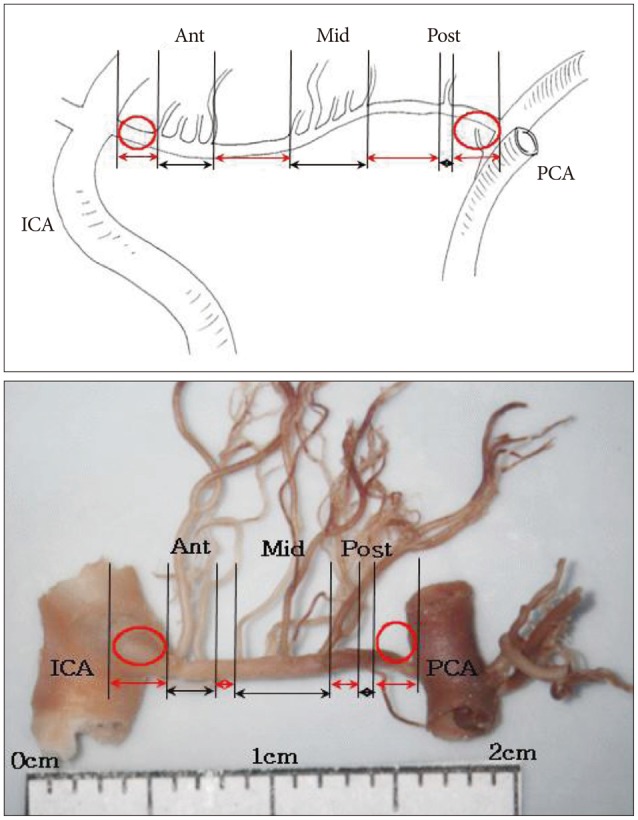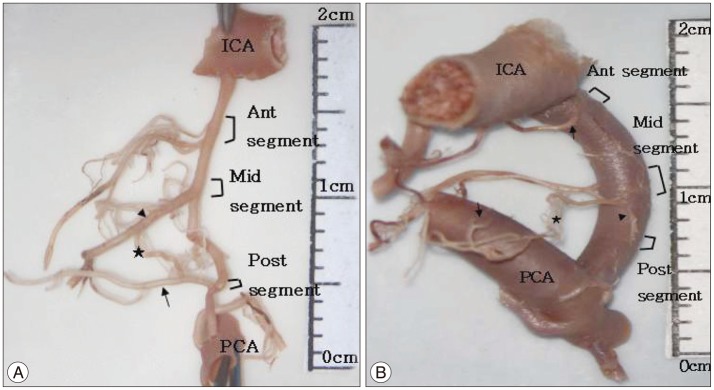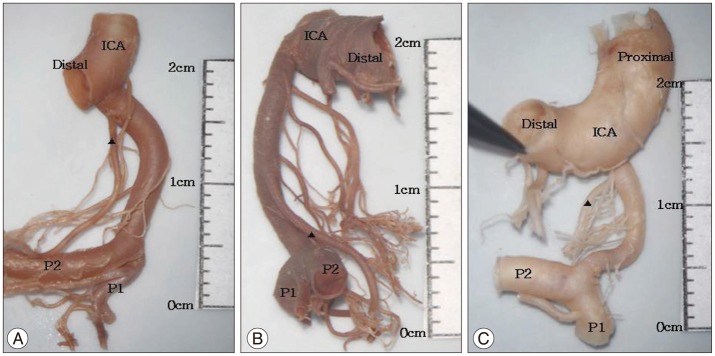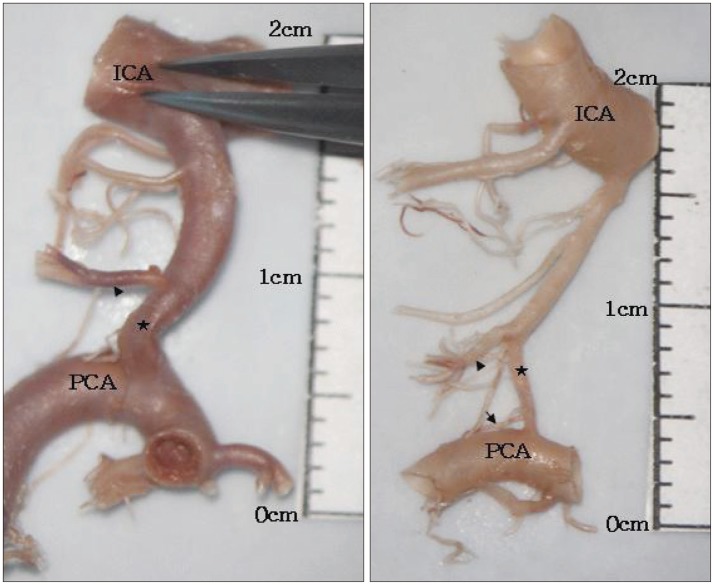J Korean Neurosurg Soc.
2015 May;57(5):350-358. 10.3340/jkns.2015.57.5.350.
Morphometric Study of the Anterior Thalamoperforating Arteries
- Affiliations
-
- 1Department of Neurosurgery, College of Medicine, Soonchunhyang University, Gumi, Korea.
- 2Department of Neurosurgery, College of Medicine, Soonchunhyang University, Cheonan, Korea. hgbaeb@schmc.ac.kr
- 3Department of Neurosurgery, College of Medicine, Soonchunhyang University, Seoul, Korea.
- KMID: 1881732
- DOI: http://doi.org/10.3340/jkns.2015.57.5.350
Abstract
OBJECTIVE
To evaluate the morphometry of the anterior thalamoperforating arteries (ATPA).
METHODS
A microanatomical study was performed in 79 specimens from 42 formalin-fixed adult cadaver brains. The origins of the ATPAs were divided into anterior, middle, and posterior segments according to the crowding pattern. The morphometry of the ATPAs, including the premammillary artery (PMA), were examined under a surgical microscope.
RESULTS
The anterior and middle segments of the ATPAs arose at mean intervals of 1.75+/-1.62 mm and 5.86+/-2.05 mm from the internal carotid artery (ICA), and the interval between these segments was a mean of 3.17+/-1.64 mm. The posterior segment arose at a mean interval of 2.43+/-1.46 mm from the posterior cerebral artery (PCA), and the interval between the middle and posterior segments was a mean of 3.45+/-1.39 mm. The mean numbers of perforators were 2.66+/-1.19, 3.03+/-1.84, and 1.67+/-0.98 in the anterior, middle, and posterior segments, respectively. The PMA originated from the middle segment in 66% of cases. A perforator-free zone was located >2 mm from the ICA in 30.4% and >2 mm from the PCA in 67.1% of cases.
CONCLUSION
Most perforators arose from the anterior and middle segments, within the anterior two-thirds of the posterior communicating artery (PCoA). The safest perforator-free zone was located closest to the PCA. These anatomical findings may be helpful to verify safety when treating lesions around the PCoA and in the interpeduncular fossa.
MeSH Terms
Figure
Cited by 1 articles
-
Endovascular Treatment of a Fusiform Aneurysm Involving a Premammillary Artery Originating from the Internal Carotid Artery: A Case Report
Se Jin Choi, Se-yang Oh, Yu Shik Shim, Dong Keun Hyun
J Cerebrovasc Endovasc Neurosurg. 2017;19(3):196-200. doi: 10.7461/jcen.2017.19.3.196.
Reference
-
1. Avci E, Bademci G, Oztürk A. Posterior communicating artery : from microsurgical, endoscopic and radiological perspective. Minim Invasive Neurosurg. 2005; 48:218–223. PMID: 16172967.
Article2. Baskaya MK, Coscarella E, Gomez F, Morcos JJ. Surgical and angiographic anatomy of the posterior communicating and anterior choroidal arteries. Neuroanatomy. 2004; 3:38–42.3. Beumer D, Delwel EJ, Kleinrensink GJ, Akouri S, Torres A, Krisht AF. The perforator-free zone of the posterior communicating artery and its relevance in approaches to the interpeduncular cistern, especially the transcavernous approach : an anatomic study. Neurosurgery. 2007; 61(5 Suppl 2):187–191. discussion 191-192PMID: 18091232.4. Bisaria KK. Anomalies of the posterior communicating artery and their potential clinical significance. J Neurosurg. 1984; 60:572–576. PMID: 6699700.
Article5. Cho YD, Jung SC, Kim CH, Ahn JH, Kang HS, Kim JE, et al. Posterior Communicating Artery Compromise in Coil Embolization of Posterior Communicating Artery Aneurysms. Clin Neuroradiol. 2014; [Epub ahead of print]. DOI: 10.1007/s00062-014-0308-4.
Article6. Debrun GM, Aletich VA, Kehrli P, Misra M, Ausman JI, Charbel F. Selection of cerebral aneurysms for treatment using Guglielmi detachable coils : the preliminary University of Illinois at Chicago experience. Neurosurgery. 1998; 43:1281–1295. discussion 1296-1297PMID: 9848841.
Article7. Duret H. Recherches anatomiques sur la circulation de l'encéphale. Arch Physiol Norm Pathol. 1874; 1:60–91.8. Duret H. Recherches anatomiques sur la circulation de l'encéphale. Arch Physiol Norm Pathol. 1874; 2:919–957.9. Endo H, Sato K, Kondo R, Matsumoto Y, Takahashi A, Tominaga T. Tuberothalamic artery infarctions following coil embolization of ruptured posterior communicating artery aneurysms with posterior communicating artery sacrifice. AJNR Am J Neuroradiol. 2012; 33:500–506. PMID: 22194388.
Article10. Foix CH, Hillemand P. Les arteres de l'axe encephalique jusqu'au diencephale inclusivement. Rev Neurol. 1925; 2:705–739.11. Gabrovsky N. Microanatomical bases for intraoperative division of the posterior communicating artery. Acta Neurochir (Wien). 2002; 144:1205–1211. PMID: 12434177.
Article12. Gabrovsky S, Laleva M, Gabrovsky N. The premamillary artery--a microanatomical study. Acta Neurochir (Wien). 2010; 152:2183–2189. PMID: 20700746.
Article13. Gibo H, Marinkovic S, Brigante L. The microsurgical anatomy of the premamillary artery. J Clin Neurosci. 2001; 8:256–260. PMID: 11386802.
Article14. Inao S, Kuchiwaki H, Hirai N, Gonda T, Furuse M. Posterior communicating artery section during surgery for basilar tip aneurysm. Acta Neurochir (Wien). 1996; 138:853–861. PMID: 8869714.
Article15. Krayenbühl N, Krisht AF. Dividing the posterior communicating artery in approaches to the interpeduncular fossa : technical aspects and safety. Neurosurgery. 2007; 61(5 Suppl 2):392–396. discussion 396-397PMID: 18091254.16. Krisht AF, Kadri PA. Surgical clipping of complex basilar apex aneurysms : a strategy for successful outcome using the pretemporal transzygomatic transcavernous approach. Neurosurgery. 2005; 56(2 Suppl):261–273. discussion 261-273PMID: 15794823.17. Lazorthes G, Salamon G. The arteries of the thalamus : an anatomical and radiological study. J Neurosurg. 1971; 34:23–26. PMID: 5539644.18. Lisovoski F, Koskas P, Dubard T, Dessarts I, Dehen H, Cambier J. Left tuberothalamic artery territory infarction : neuropsychological and MRI features. Eur Neurol. 1993; 33:181–184. PMID: 8467830.
Article19. Pedroza A, Dujovny M, Artero JC, Umansky F, Berman SK, Diaz FG, et al. Microanatomy of the posterior communicating artery. Neurosurgery. 1987; 20:228–235. PMID: 3561728.
Article20. Pedroza A, Dujovny M, Cabezudo-Artero J, Umansky F, Berman SK, Diaz FG, et al. Microanatomy of the premamillary artery. Acta Neurochir (Wien). 1987; 86:50–55. PMID: 3618306.
Article21. Pelz DM, Lownie SP, Fox AJ. Thromboembolic events associated with the treatment of cerebral aneurysms with Guglielmi detachable coils. AJNR Am J Neuroradiol. 1998; 19:1541–1547. PMID: 9763391.22. Percheron G. The anatomy of the arterial supply of the human thalamus and its use for the interpretation of the thalamic vascular pathology. Z Neurol. 1973; 205:1–13. PMID: 4126735.
Article23. Regli L, de Tribolet N. Tuberothalamic infarct after division of a hypoplastic posterior communicating artery for clipping of a basilar tip aneurysm : case report. Neurosurgery. 1991; 28:456–459. PMID: 2011233.
Article24. Saeki N, Rhoton AL Jr. Microsurgical anatomy of the upper basilar artery and the posterior circle of Willis. J Neurosurg. 1977; 46:563–578. PMID: 845644.
Article25. Sugita K, Kobayashi S, Shintani A, Mutsuga N. Microneurosurgery for aneurysms of the basilar artery. J Neurosurg. 1979; 51:615–620. PMID: 501400.
Article26. Tummala RP, Chu RM, Madison MT, Myers M, Tubman D, Nussbaum ES. Outcomes after aneurysm rupture during endovascular coil embolization. Neurosurgery. 2001; 49:1059–1066. discussion 1066-1067PMID: 11846898.
Article27. Umredkar A, Gupta SK, Khandelwal N, Chhabra R, Mathuriya SN, Pathak A, et al. Intracerebral infarcts following clipping of intracranial aneurysms : incidence, clinical correlation and outcome. Br J Neurosurg. 2010; 24:156–162. PMID: 20210531.
Article28. Vincentelli F, Caruso G, Grisoli F, Rabehanta P, Andriamamonjy C, Gouaze A. Microsurgical anatomy of the cisternal course of the perforating branches of the posterior communicating artery. Neurosurgery. 1990; 26:824–831. PMID: 2352600.
Article29. Viñuela F, Duckwiler G, Mawad M. Guglielmi detachable coil embolization of acute intracranial aneurysm : perioperative anatomical and clinical outcome in 403 patients. J Neurosurg. 1997; 86:475–482. PMID: 9046305.
Article30. Yasargil MG, Antic J, Laciga R, Jain KK, Hodosh RM, Smith RD. Microsurgical pterional approach to aneurysms of the basilar bifurcation. Surg Neurol. 1976; 6:83–91. PMID: 951657.
- Full Text Links
- Actions
-
Cited
- CITED
-
- Close
- Share
- Similar articles
-
- Morphological Characteristics of the Thalamoperforating Arteries
- Glue Embolization of Ruptured Anterior Thalamoperforating Artery Aneurysm in Patient with Both Internal Carotid Arteries Occlusion
- Computerized Tomography Findings Suggesting Non-aneurysmal Spontaneous Subarachnoid Hemorrhage
- Upper Brain Stem Lesions Diagnosed by Serial Vertebral Angiography
- Infraoptic Course of Both Anterior Cerebral Arteries








